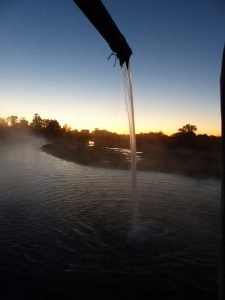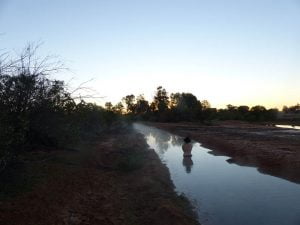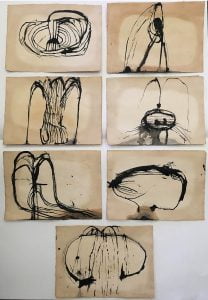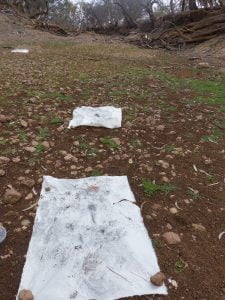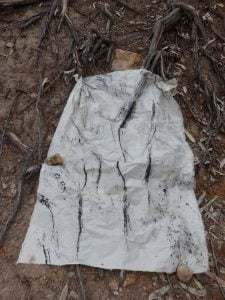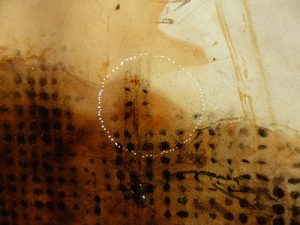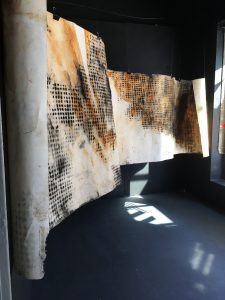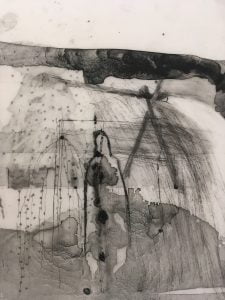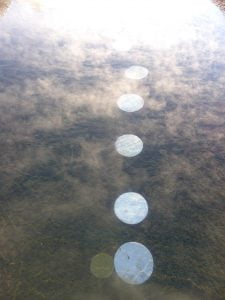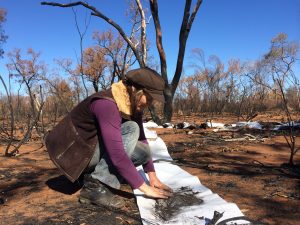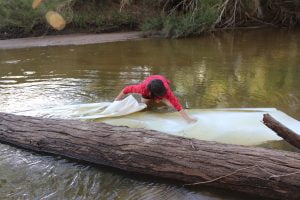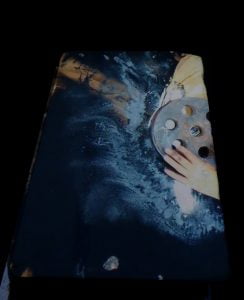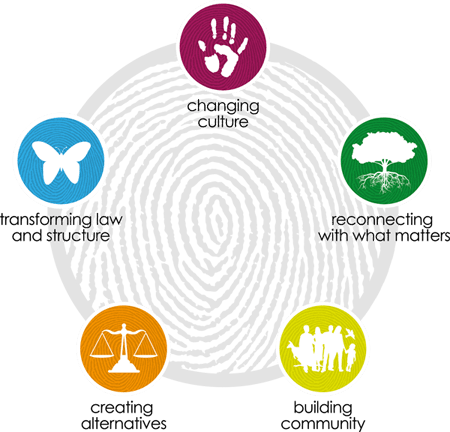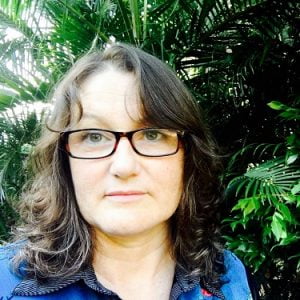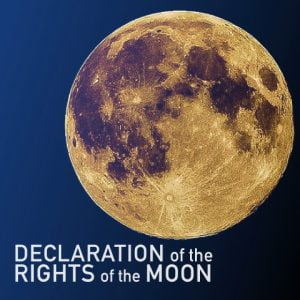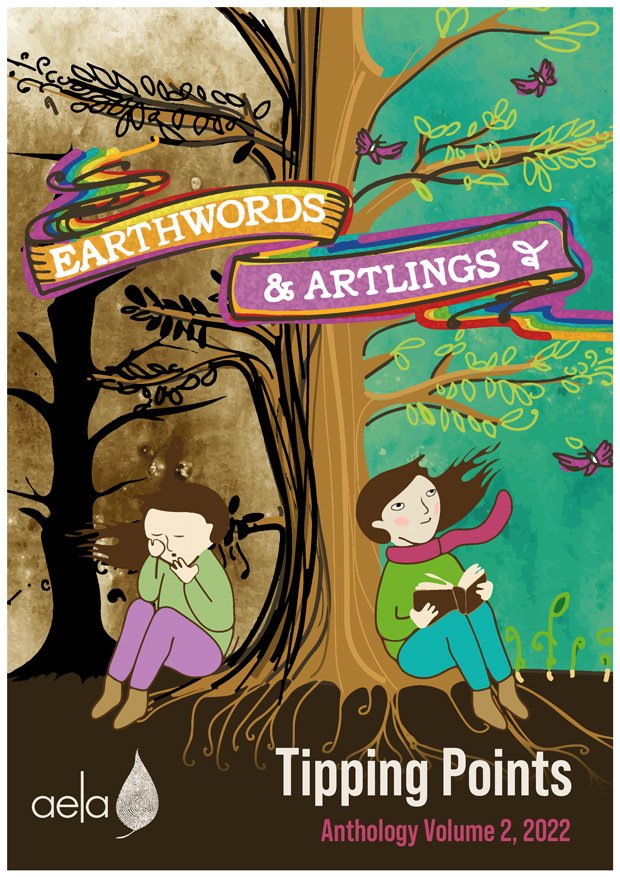For information about Jude’s work please visit her website.
To read her feature article for the August 2017 Earth Arts newsletter, please click here for a PDF version, or scroll down.
Drawing the Earth
During the 1960’s I grew up in various regions of Australia and finally to suburban Sydney in 1965. At school, we learnt about ‘Great’ phenomena such as the Great Artesian Basin (GAB) and the Great Barrier Reef. The class were given purple ink copies of maps of Australia. I took great care in colouring in these maps but only years later did I realize that what I was drawing were the symbols of vast geological, ancient, and complex structures. As many others of my generation, it took many more years to become conscious of the indigenous presence, histories, false perceptions and the ongoing impacts of colonisation within these environmental systems.
As one of several artists present at the Peoples’ Tribunal for the Rights of Nature in 2016 at the Brisbane Law Courts I listened to the testaments of elders, scientists and lawyers who have generational experience, knowledge and/or years of research on specific areas across Australia.
The speakers painted a picture of devastating changes in our environments and I along with others in the audience felt an overwhelming feeling of urgency to support the legal and environmental changes needed to stop the destruction and potential annihilation of Australia’s ‘Great’ natural environments.
The artists including myself are part of the Australian Earth Laws Alliance (AELA) arts collective whose aim is to raise the consciousness of the issues of the Tribunal, Earth Jurisprudence and the Rights of Nature by exploring the various themes together and ultimately taking projects to various urban and regional areas.
For me, I was particularly interested in the testament presented by Michael Connolly, a Kullilli and Muruwari man from Charleville and now Redcliffe, Queensland. He talked about the Great Artesian Basin, the vast subterranean reservoir that extends to the size of 22 percent of Australia, the only reliable water source to many areas of Inland Eastern Australia. For thousands of years, artesian springs drawing from this hidden water resource sustained life for indigenous peoples who still maintain sacred connections to these springs and waterholes.
Michael stated that it has been the springs that determined the telegraph, roads, exploration, seismic lines and routes that have developed since colonisation. Early European explorers and settlers capitalised on the knowledge and navigational skills of indigenous people in terms of tracks, water locations and water signs. Today in Australia there is still a continuation of the exploitation and destruction of lands and the lives of indigenous peoples.
One of the reasons for my interest in the GAB is that I lived in the Maranoa, Wallam catchment areas of Western Queensland for many years. In 2015 I completed a Doctorate of Visual Art in which I researched drawing methods to visualize the landscapes that we cannot visibly experience, in particular the Great Artesian Basin. I am interested in the interconnected activities of human, water and land systems.
During the research, I was fascinated by archived photographs of early construction of bores in Western Queensland. During the late 19th century artesian bores were drilled and great excitement grew as the ‘inexhaustible’ supply of artesian waters gave hope to arid regions of Australia. People travelled hundreds of miles to witness this phenomena.
One photograph shows the fountains of water spurting from a bore head in Charleville in 1889 that reached heights of over 36 metres1 throwing up pieces of an ancient landscape of fossilized rocks and ferns. This tremendous water pressure soon subsided as more bores were drilled.
Springs and rivers have been read as miraculous phenomena by human beings in their struggles for survival, and ancient cultures across the world have associated them with spiritual power; even today, they still carry a mythological status. Previously, Western ideology have represented rivers and their sources as powerful, untapped wildernesses, or cascading flows of greatness, which invariably contribute to visionary myths of infinite resources and eternal abundance. Over the past century, the construction of thousands of bores has reduced artesian pressure, with a cataclysmic effect on the activity and ecology of springs.2 Research indicates that because droughts are a subjective notion, the once soft grounds that let moisture into the earth to replenish springs, soaks, caches and wetlands no longer exist in Australia.3 Only half the water sources that the Murray-Darling catchment encompassed in 1788 exist today, so that “rain which broke a drought then does not now.”4
Since the 1960s, the acceleration of environmental changes have been tremendous. Artists have reacted to the fears of increasing industrialisation and ecological threats, including climate change, and have expanded the ways that they relate to the places we live in and the impacts that humans have on the land. A new vocabulary has emerged and therefore a new narrative is evolving with arts and literature. Words introduced into the dictionary such as Anthropocene, solastalgia, shadowtime, great acceleration, all indicate the massive and destructive changes happening in our lifetime.
Artists now consider the social use of sites as a continuing narrative of which the artist is another part. As a result, contemporary artists are often part of common goal projects, collaborations and/or participatory projects.
Many artists work without knowing the full outcome of a project but this leaves the process open to make some unexpected discoveries. For my art making methods, I use elements of chance, transfer processes and drawing in situ. Further work develops in the studio but my aim is to show a continuum of place on the specific sites.
When first encountering a landscape, I draw what is visibly around me. I take photographs, soak papers, collect sediments, make rubbings and record sounds and moving images of the environment. Often I immerse myself in the artesian bore drains, dams, and rivers which combine as a collection of my experience of that particular site.
Materials such as paper are intrinsic to my ideas not only because of its absorption and durable properties but the metaphysical associations. These qualities make it more accessible to document the experience of drawing and the moving body in the watershed spaces. I began using paper to layer sediments and pigments, while keeping former layers underneath. Papers, particularly those of the lighter Japanese variety, can be manipulated to cover objects in the landscape while taking rubbings (transfer drawings), including steel equipment, netting fences and organic textures. The crushed shapes embossed from the objects form a sculptural element to the work. The paper is often left with buckles and is not pressed flat, creating a topographical intent. Paper is more deceiving than it appears. It can connate an indestructibility of life, yet at any moment can become fragile and tear or disintegrate especially when exposed to water. Paper has a material history to the earth itself in the form of tree fibres and other vegetation. Some paper is also transparent, especially kozo. When using oily crayons rubbed against a surface, this transparency is heightened. Paper has a memory of where it was rolled, folded and creased and so can take on something of the surface it once laid upon.
The process of working flat on the water and banks of the river articulates an immediate and visceral engagement with the river and has the potential to link the connection of surface waters to the artesian basin. Working ‘flat’ is also a method I use to encourage water and pigments to create another perspective. At water sites, I have soaked papers, collecting sediments as the water pools or flows over the surface. These works on paper are records of events and time, which anticipate the changes of both natural and human-made elements. For example, when the permanent water hole on the Wallam was unexpectedly exposed through drought, I was given an opportunity to experience this creek bed that I had never seen or felt before. I captured the different textures of the creek bed on forty sheets of paper. This resulted in Geo-graphis (2015), a vertical and horizontal layering of the interconnections of the ephemeral watershed.
One project I am working on for the AELA Earth Arts Collective is a video installation using footage taken in June 2017 during a trip to Cunnamulla. I placed a collection of silver dinner mats, which historically have been used as table settings in pastoral domestic life, on the base of the bore drains under the hot 50 degree artesian water. I filmed the marine life, steam and flow of the water as it moved over the reflective surfaces.
Living in a city, one can be removed from where resources are extracted, produced or grown. Environmentalist Val Plumwood states that what is going on in another part of the country “represents the destructive demands imposed on one place by another place.”5 This is a major issue happening in mining and agricultural regions of Australia including the areas that I have lived and visited on the Great Artesian Basin. I have seen an enormous environmental visual change in Western Qld since I left 12 years ago when I moved to Brisbane. My ideas are focused on bringing land/water issues into the domestic space, as it is important to connect these issues with our everyday lives.
I would like to acknowledge the Gungarri, Bidjarra and Kooma people of Western Queensland, Maranoa and Nebine area who are the traditional custodians of the land that is the area of my research.
1. Owen Powell, “Great Artesian Basin; Water from Deeper Down” Queensland Historical Atlas
2. R.J Fairfax and R.J. Fensham, "In the Footsteps of J. Alfred Griffiths: A Cataclysmic History of Great Artesian Basin Springs in Queensland, Australia.," Australian Geographic Studies 40, no. 2 (2002).
3. Bill Gammage, The Biggest Estate on Earth: How Aborigines made Australia (Sydney: Allen and Unwin, 2011).
4. Bill Gammage, The Biggest Estate on Earth: How Aborigines made Australia (Sydney: Allen and Unwin, 2011).
5. Plumwood, V, 2008, Philosophy and the Natural World - Sourced http://www.abc.net.au/radionational/programs/philosopherszone/philosophy-and-the-natural-world---val-plumwood/3291526#transcript
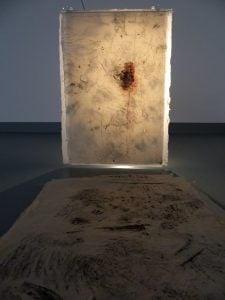
Geo-graphis (Drawing the Earth), 2015, lithographic crayon on kozo paper, plastic rod, light and stand, dimensions variable. Photo: Jude Roberts.
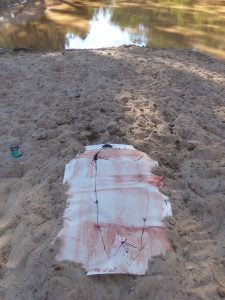
Work in progress, drawing the water hole on Maranoa River, ochre, gesso and ink on kozo paper, 2017.
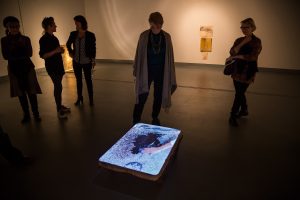
Land writing (wiping), 2015, video projection onto lithographic stone, Installed for Drawing the Artesian, White Box, Griffith University, Brisbane, 2015, Photo Miriam Deprez














